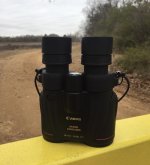Theo98
Eurasian Goldfinch
Ted,
I did think that it was an individual visual phenomenon. Probably only some children and lucky adults have 'perfect' vision, with no spikes or artifacts...Enjoy the Canon 10x42 L.
Binastro,
It does "appear" an anomaly with my vision. It is a little puzzling as I see no similar double focus characteristics in any of my bino investments, and never have before in the multiple units I've had the pleasure to casually glass with. I had my cataract surgeries 2 years ago and the Canon is the only unit I see this in. Peculiar, but since I've not read or heard of this before from any other Canon IS users, the special high-end eye lenses I chose (complete far and near sighted corrections in each eye) apparently impacts the Canon 10x42L usage for me in this weird way. Being this as a fact of life for Me, I will not steer any potential users away from their interest and usage of the optical prowess of the Canon 10x42L IS!
Interestingly, I can verify "sample variations" exist, even in the long standing top-end Cannon IS products. Although the newest unit performed to my eyes in similar fashion as did the first unit (dual focus ranges), there was a slight "nervousness" to the IS image. It clearly displayed small undulations in response to my heartbeat! After using it for about 3 to 4 hours, this never improved. My spouse also confirmed this as she saw the same "twitches" during IS engagement. It may have needed more hours of use to "break-in", but I didn't give it that opportunity, the new one I sent back for a refund.
From the first moment of use, my original 10x42L pair had rock-solid IS function, creating a hand-held sight picture that always appears as if they are mounted on a tri-pod! This is also how my spouse described the stability differences as she compared the two units side by side. With just 6 weeks of usage between these, it was a no-brainier to keep the original 10x42L IS!!
I still state and believe that due to product variances and individual perceptions, when possible, I recommend to Try before you Buy!! :t:
Ted





